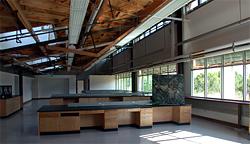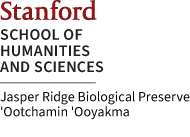Leslie Shao-ming Sun Field Station
A Case Study in Sustainable Design and Construction
"We shape our buildings; thereafter they shape us." --WINSTON CHURCHILL
Deciding to build a new field station at Jasper Ridge Biological Preserve presented intrinsic conflicts. The building would inevitably contribute to some of the current environmental problems which researchers study at the Preserve. The solution? A building design that minimizes its environmental footprint and serves as an educational tool to demonstrate principles of sustainability and energy efficiency.

With this in mind, the Leslie Shao-ming Sun Field Station was designed for an annual energy budget of net zero carbon emissions and to reduce the consumption of virgin materials. The result? An award-winning research and educational facility.
Energy Systems and Efficiency Features
The combustion of fossil fuels, currently our predominant source of energy, results in the release of carbon dioxide into the atmosphere. Buildings, as a result of their energy consumption, are responsible for a third of all U.S. carbon dioxide emissions (U.S. Department of Energy, Energy Information Administration 1999).
To lessen its impacts, the Sun Field Station was designed with a goal of zero net carbon emissions for its annual energy budget. The use of renewable energy sources (the sun's resources are used for electricity, heat, and light) and reduction of overall energy consumption (through efficiency and clever design) both help to reduce the environmental impact of the building. The following features contribute to the energy efficiency ofthe Sun Field Station: Renewable Energy
22kW grid-connected photovoltaic system for net generation of electricity and a real-time monitoring system of the building's energy performance viewable online. When excess energy is produced by the building's photovoltaic system, it is sent to the grid.

Solar heating system that provides 60-80% of the total energy for winter heating. As a bonus, the solar collectors shade south-facing windows, thus contributing to passive cooling of the building.
Energy Design and Efficiency
- Passive cooling design that includes insulation, high-performance glazing, operable windows, shading, and diffuse daylighting. The design eliminates the need for air conditioning in over 90% of the interior building space.

- In addition to the south-facing windows, north-facing windows and light monitors provide ergonomically superior diffuse light to meet daytime lighting needs.
- All appliances are Energy Star rated for energy efficiency. Full spectrum fluorescent lights and state of the art electronic ballasts provide efficient and high quality lighting.
- The roof exterior is insulated to reduce thermal loss and increase efficiency.
Sustainable Materials
Buildings consume two-fifths of all material (Worldwatch Institute, 1995) and use onequarter of the world's virgin wood harvest (Environmental Building News, Industry Statistics. May 2001). The choice of building materials–and their associated extraction, processing, and transportation impacts–was an essential part of the Sun Field Station's sustainable design.
The following examples highlight salvaged, recycled, and low environmental impact materials:
- The manufacture and use of cement is responsible for about 8% of global carbon emissions. By using high fly ash concrete to significantly reduce the cement content in the building's concrete,
approximately 15 tons of CO2 emissions were avoided. Furthermore, over 15 tons of fly ash–a waste byproduct of coal combustion–were diverted from the landfill.
- All redwood for the exterior siding was salvaged, the majority coming from a 50-year-old home in the adjacent Town of Woodside and a building on the Stanford campus.
- The 120-year-old bricks that line the main and rear entrances were excavated from Jane Stanford's original residence on the main Stanford University campus that was damaged in the 1906 earthquake. These bricks initially came to California from Scotland in the 1880s as ship ballast.
- The Forest Stewardship Council certified all lumber as sustainably harvested in Mendocino County.
- No materials used inside the building contain volatile organic compounds (VOCs) that have a negative impact on indoor air quality and human health.
- With the exception of the kitchen, all casework was salvaged from a biotech firm in the East Bay.
- Bathroom partitions were salvaged from Stanford University's 1902 Old Chemistry Building.
- The building's steel framing incorporates more than 80% recycled content and recycled newsprint was used for wall insulation.

Water Conservation
-
Waterless urinals and low-flow toilets help to conserve water.
-
Native landscaping includes native honeysuckle on the trellis along the south side of the building for shading and cooling.
-
A 25,000 gallon cistern captures and stores rainwater from the building's roof for later use.

Other Design and Construction Features
-
Site selection criteria included: good solar access and orientation; no loss or impact to significant habitat; no archaeological resources at risk; a setback of at least 250 feet from a water source (lake or creek).
-
Construction site management included fencing to ensure that no mature oaks were damaged or lost during construction. In addition, a snag that is also an acorn woodpecker granary was preserved near the building.
-
The building was engineered to have no loadbearing walls and other features that reduced the total lumber and steel framing. This also allows for easy renovation and alteration of the interior floorplan.
-
Operable windows in all occupied spaces allow customization of the indoor environment.

Awards Received for Sun Field Station Design
- The American Institute of Architects (AIA) 2005
- The American Institute of Architects (AIA) and its Committee on the Environment (COTE) selected the Leslie Shao-Ming Sun Field Station as one of eight examples of architectural and "green" design solutions that protect and enhance the environment.
- The Sun Field Station was Stanford's first green building, and is now viewed by the campus as an important display of leadership that makes a statement about the importance of conserving natural resources.
- Recycleworks Green Building Award 2003 - The building was the first commercial green building award winner from
Sustainable San Mateo County.
Additional Links and Information
- See monitoring of current building energy consumption and production online.
- Learn more about green/sustainable building designs and strategies at the following websites: www.eere.energy.gov/buildings/ and usgbc.org/
Project Details
Project description: Field research station with space for researchers, classes, staff, and collections (new construction)
Owner: Stanford University
Location: San Mateo County, CA
Size: 9,800 square feet interior space, 13,200 square feet exterior footprint
Construction cost: $3.29 million
Cost per square foot: $249
Completion date: June 2002
Awarded first San Mateo County Green Building Award: 2002 -- www.recycleworks.org
Project Team
Architect: Rob Wellington Quigley, FAIA, Catherine Herbst
Stanford Capital Management and Planning: Laura Goldstein, Ted Giesing
General Contractor: W. L. Butler Construction – Mark Von Holle, Cary Tronson
Solar Heating Design: Taylor Engineering LLC – Allan Daly
Structural Engineer: EndresWare – Paul Endres
Electrical Design/Build: Redwood City Electric
Mechanical Design/Build: Cal-Air, Inc.
Environmental Consultants: David Gottfried, Allan Daly
Jasper Ridge Biological Preserve: Philippe Cohen, Nona Chiariello, Cindy Wilber
For more information, contact:
Jasper Ridge Biological Preserve
Stanford University
Stanford, CA 94305-5020
(650) 851-6813
Sun Field Station Virtual Reality Tour
Take a virtual tour of the Sun Field Station with 360-degree views from inside and outside the building. Go to Virtual Tour



